World Heart Day
World Heart Day

World Heart Day!
The powerhouse of the body, beating 100,00 times every day, pumping eight pints of blood, through an intertwining network of blood vessels. Delivering oxygen and nutrients to muscles and the vital organs of the body. The centrepiece, what keeps us alive, the heart!
Why put strain on the very thing that keeps us alive? The heart is the most important muscle working constantly, embracing a healthy lifestyle can lower the risk of developing a stroke or heart attack, and can prevent cardiovascular disease. No matter your age young or old, you can begin to take care of your heart. Making healthier choices, watching what you eat, exercising regularly are all good habits to start or continue to look after your precious heart.

Randox Laboratories offer a wide selection of Reagents specifically for Lipid testing. Lipid tests are the most important cardiac risk tests. They assess an individual’s risk of a stroke or heart attack and can provide an indication if someone is going to have a cardiac episode, caused by blockages of arteries and blood vessels. Lipid tests screen for abnormalities of cholesterol and triglyceride levels in the blood, allowing for preventative measures to take place to reduce the chances of cardiovascular diseases.
Complete lipid profiles consist of HDL Cholesterol, LDL Cholesterol, Total Cholesterol and Triglycerides. These profiles measure the current cholesterol and triglycerides levels also, measuring potential emerging risk factors of cardiovascular disease.
‘Benefits of Randox’s Lipid testing includes;
Enhanced convenience with liquid ready-to-use reagents (Triglycerides kits also come in lyophilised form)
Excellent correlation to reference methods for security of accurate results
Applications for a wide range of clinical chemistry analysers
Wide measuring ranges able to comfortably detect abnormal lipid levels.
Cost effectiveness for even small throughput labs – all lipid assays are stable to expiry when stored at 2-8⁰C (except for Triglyceride kits, stable for 21 days)’
Randox provides the “only direct automated sdLDL-C kit on the market, The Randox sdLDL-C test, is a direct method for the quantitative determination of sdLDL-C using automated chemistry analysers, capable of accommodating two-reagent assays. The assay consists of two steps, and is based on the use of well-characterised surfactants and enzymes, that selectively react with certain groups of lipoproteins.
Benefits include,
Direct, automated test for convenience and efficiency
Rapid analysis results can be produced in as little as ten minutes, facilitating faster patient diagnosis and treatment plan implementation.
Good correlation to the gold standard ultracentrifugation method
Liquid ready-to-use reagents for convenience and ease of use
Applications available detailing instrument specific settings for a wide range of analysers
Clearance method sdLDL-C controls and calibrator available.
One of Randox’s Reagents offered is the Lipoprotein (a) assay known as Lp(a). It is similar to LDL cholesterol but a lot more viscous.
High levels of lipoprotein can clog arteries very easily, leading to the potential of a stroke or cardiovascular disease at any age. Lp(a) is made in the liver containing fat and protein, their main role is to carry lipids around the body. Lp(a) remains relatively stable over a lifespan and is determined predominantly through genetics. Just a single Lp(a) test is believed to be enough to improve accuracy of a cardiovascular risk assessment. Repeat testing can also be initiated if a secondary cause is suspected, or therapeutic measures to lower Lp(a) levels have been investigated.
Benefits of the Lp(a) assay;
WHO/IFCC Reference Material
Dedicated Five-Point Calibrator Available
Excellent Correlation
Excellent Precision
Liquid Ready-To-Use
Applications Available
References
BHF (2023) How your heart works, British Heart Foundation. Available at: https://www.bhf.org.uk/informationsupport/how-a-healthy-heart-works (Accessed: 19 September 2023).
Family Doctor (2023) Keeping Your Heart Healthy, familydoctor.org. Available at: https://familydoctor.org/keeping-heart-healthy/ (Accessed: 19 September 2023).
Heart UK (2023) High lipoprotein(a), What Is High lipoprotein(a)? | Cholesterol Conditions | HEART UK. Available at: https://www.heartuk.org.uk/genetic-conditions/high-lipoproteina (Accessed: 20 September 2023).
Randox (2023b) Lipid: Reagents, Randox Laboratories. Available at: https://www.randox.com/lipid-reagent (Accessed: 19 September 2023).
Charting the Course to Laboratory Excellence
Are you still using spreadsheets for your QC data and Charts?
You’ve been left behind.
But don’t worry!
Your laboratory’s ultimate ally in the quest for precision and excellence has arrived.
Acusera 24.7 is a tool that not only streamlines your QC data but also empowers you with a treasure trove of invaluable charts.
These charts are more than just numbers and lines; they are your secret weapon for troubleshooting, achieving accreditation, and driving continuous process improvement.
Acusera 24.7 doesn’t just offer charts. It offers a symphony of insights at your fingertips. From the precision of interactive Levey-Jennings charts to the competitive edge of performance summary charts for peer group comparison, from the rhythm of weekly mean charts to the clarity of reliable SD histograms – these charts are your compass in the world of quality control.
The best part?
You’re in control.
Tailor these charts to your unique needs, whether you’re dealing with single or multiple analytes, an abundance of QC lots, fixed or variable SDs, or need to pinpoint data within a specific date range.
Join us on a journey through the world of Acusera 24.7’s charts, where data becomes your strategic advantage, and discover why more laboratories are choosing Acusera 24.7 for QC data management every day.
Levey-Jennings Charts
Every laboratorian has seen countless Levey-Jennings charts and for good reason.
These charts are the unsung heroes of quality control in the laboratory.
They offer a visual snapshot of data over time, helping to detect trends, outliers, and systematic errors that might otherwise go unnoticed. Levey-Jennings charts are like the heartbeat monitor of your laboratory, providing real-time insights into the health of your analytical processes.
We’ve taken Levey-Jennings charts to the next level.
Our colourful graphs might look like they belong in a modern art museum, but trust me, they’re more than just eye candy.
Acusera 24.7’s Levey-Jennings charts are like the laboratory’s personal detective, sniffing out anomalies and shifts and making sure your QC data behaves.
Let’s have a look at what you can do with the Acusera 24.7 interactive Levey-Jennings charts.
The screenshot below shows a Levey-Jennings chart for a single analyte, with the date on the X-axis and SD on the Y-axis. On this chart, you can see data points displayed in different colours. Green data points indicate an acceptable result. Orange points show data that has triggered your predefined alert criteria, while red points are those that have broken your set rejection rules.
The lines marked on the chart below represent events that have been recorded. Instrument events such as calibration events or maintenance can be recorded to monitor their effects on your QC, allowing you to quickly see how these events relate to any deviations or improvements in your QC data. For example, after the event labelled ‘Reagent lot change’ you can see a series of alerts and failures. Marking this event on the chart allows for an at-a-glance explanation of this deviation. These events are completely customisable so you can record any relevant information you want!
Finally, data points that appear as a triangle indicate a comment has been added. What text is included in the comment is completely up to you!
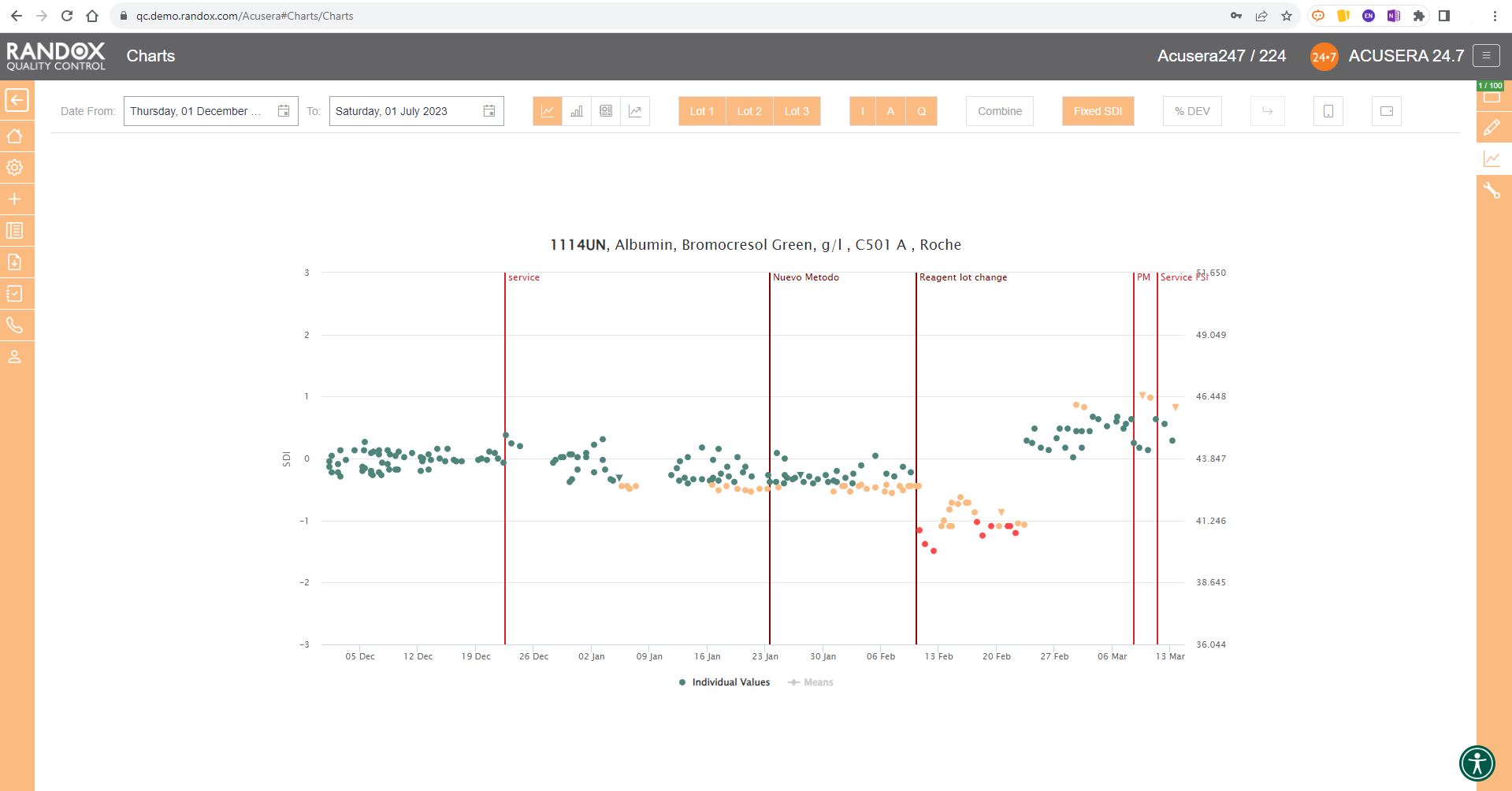
The next screenshot below shows a Levey-Jennings chart containing QC data for all the tests included in the Clinical Chemistry Panel.
Acusera 24.7 panels allow you to group related tests together, helping increase the efficiency of your data review.
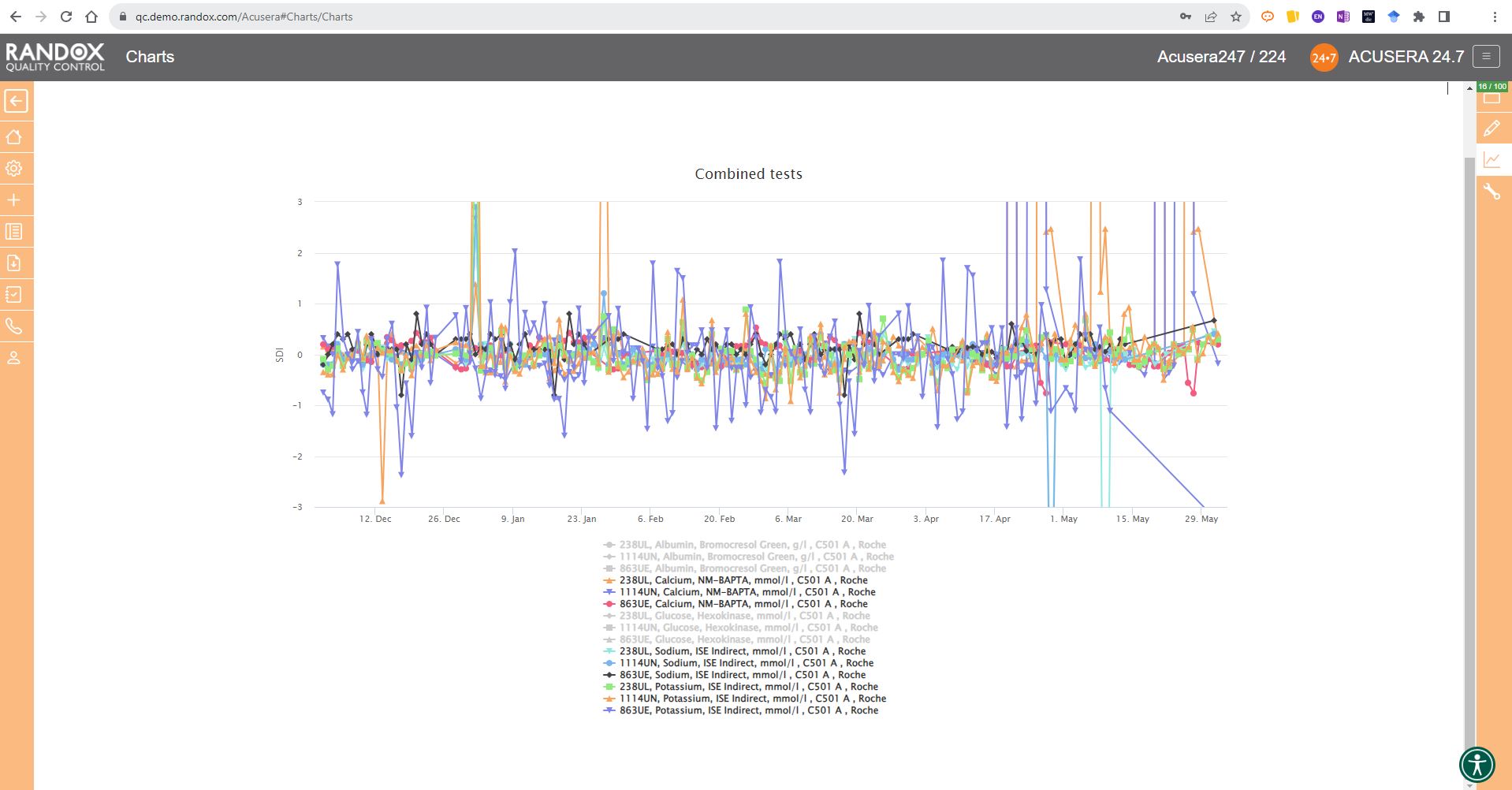
It looks great, right?
Maybe a little confusing.
The screenshot is perhaps a little deceptive.
When viewing these charts live, you can view the data as a whole, or home in on individual data sets by simply hovering over the data you want to see. You can also selected a deselect datasets at will by clicking on its name in the list below the chart.
The screenshot below shows an example of this.
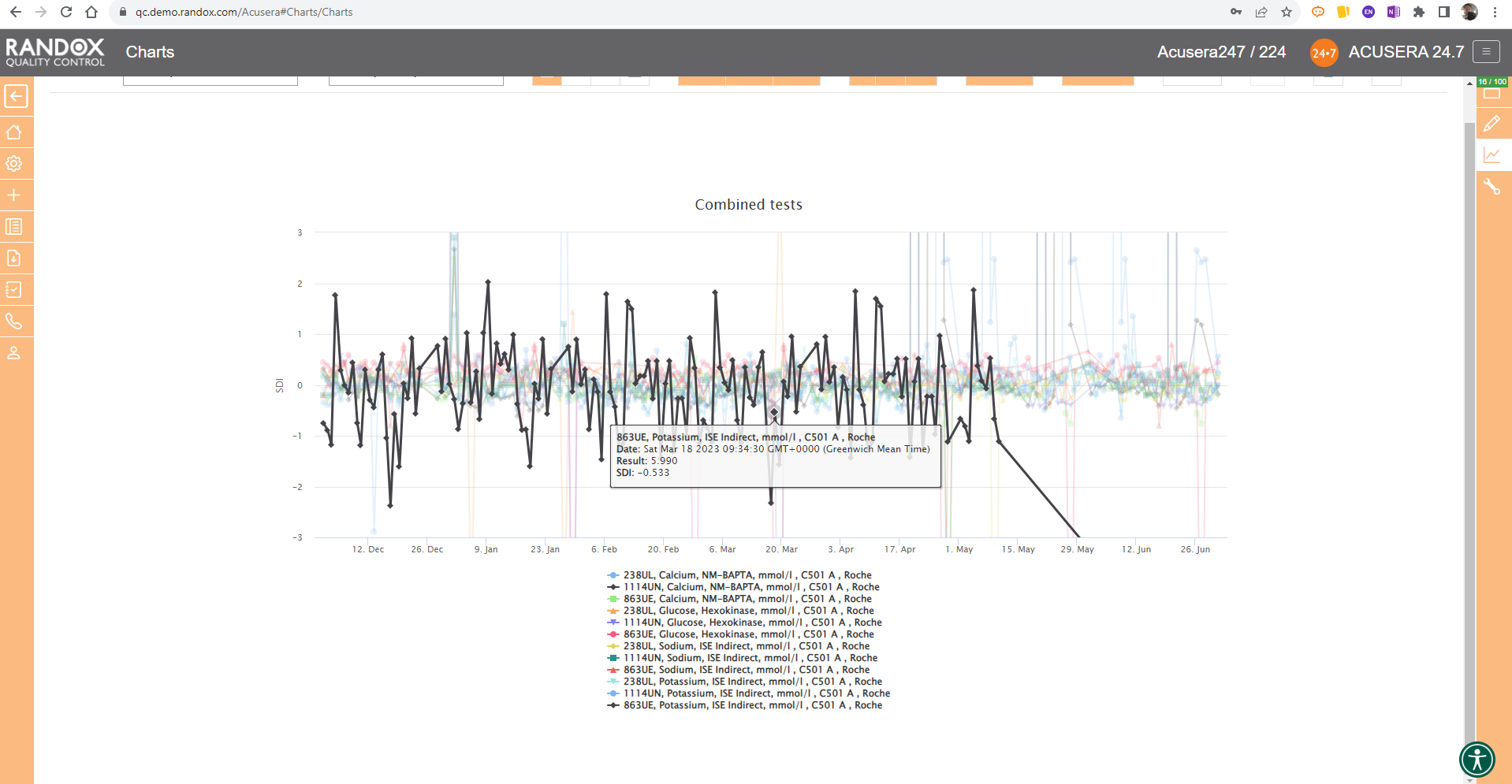
All the charts we’ve looked at so far have had a fixed 3SD on the Y-axis.
For a more in-depth review of your data, you may wish to expand this axis.
With the click of a button, you can expand the Y-axis to include all your data points. See below for an example.

In some cases, you may wish to view this data displayed as ‘% Deviation’.
Again, with the click of a single button, you can convert the Y-axis to show just that, as shown below.
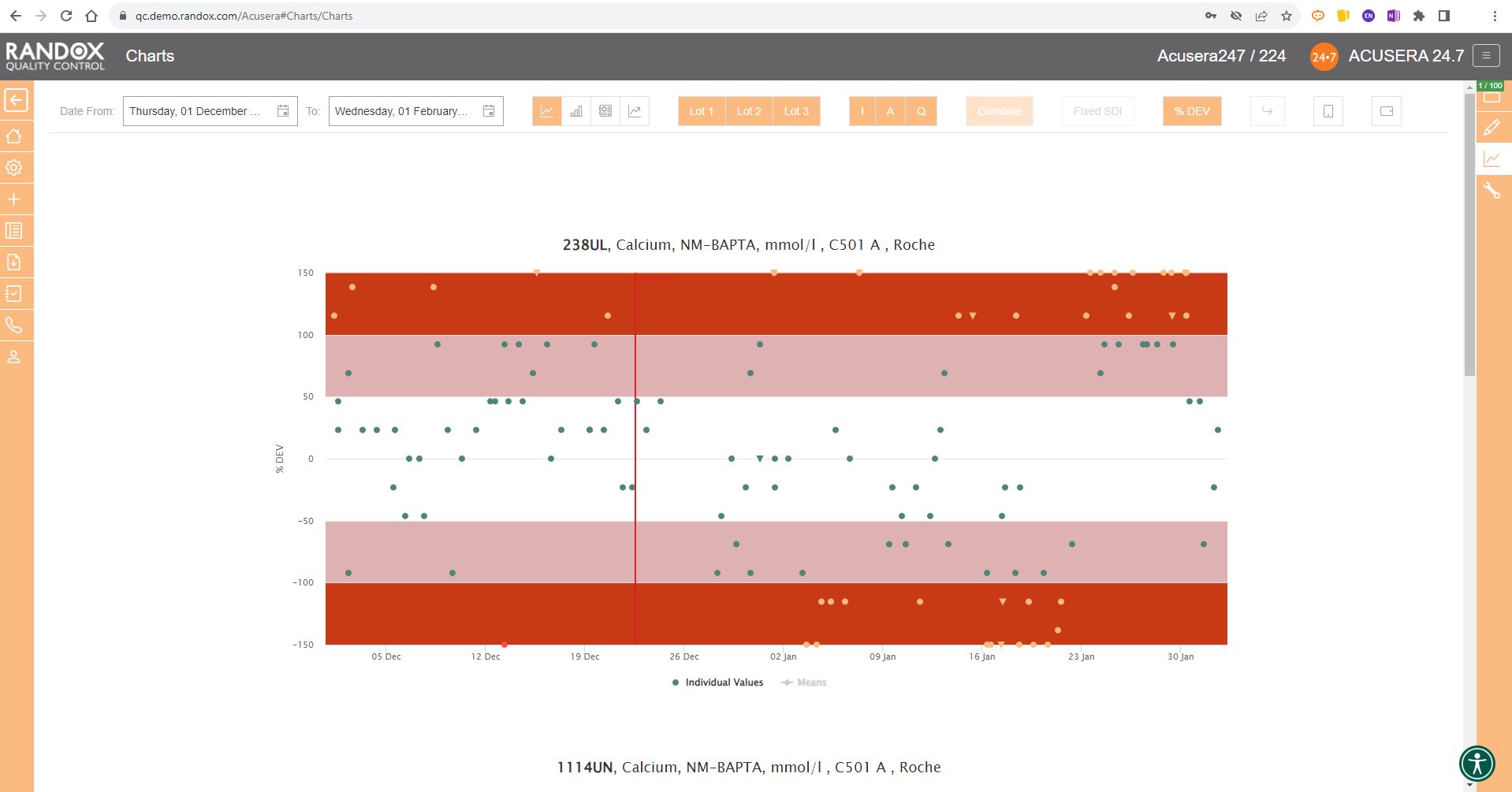
Performance Summary Charts
Peer group comparison of IQC data has a lot of benefits.
Comparing your data with other laboratories that use the same QC lot, instrument, method and more, can help you with troubleshooting and continuous process improvement.
The Acusera 24.7 Performance Summary Charts do all the work for you.
As shown in the screenshot below, these charts display your data and how it compares to your peers including mean, CV, and SD.
You can also view this data in a table to get a more detailed picture of your performance.
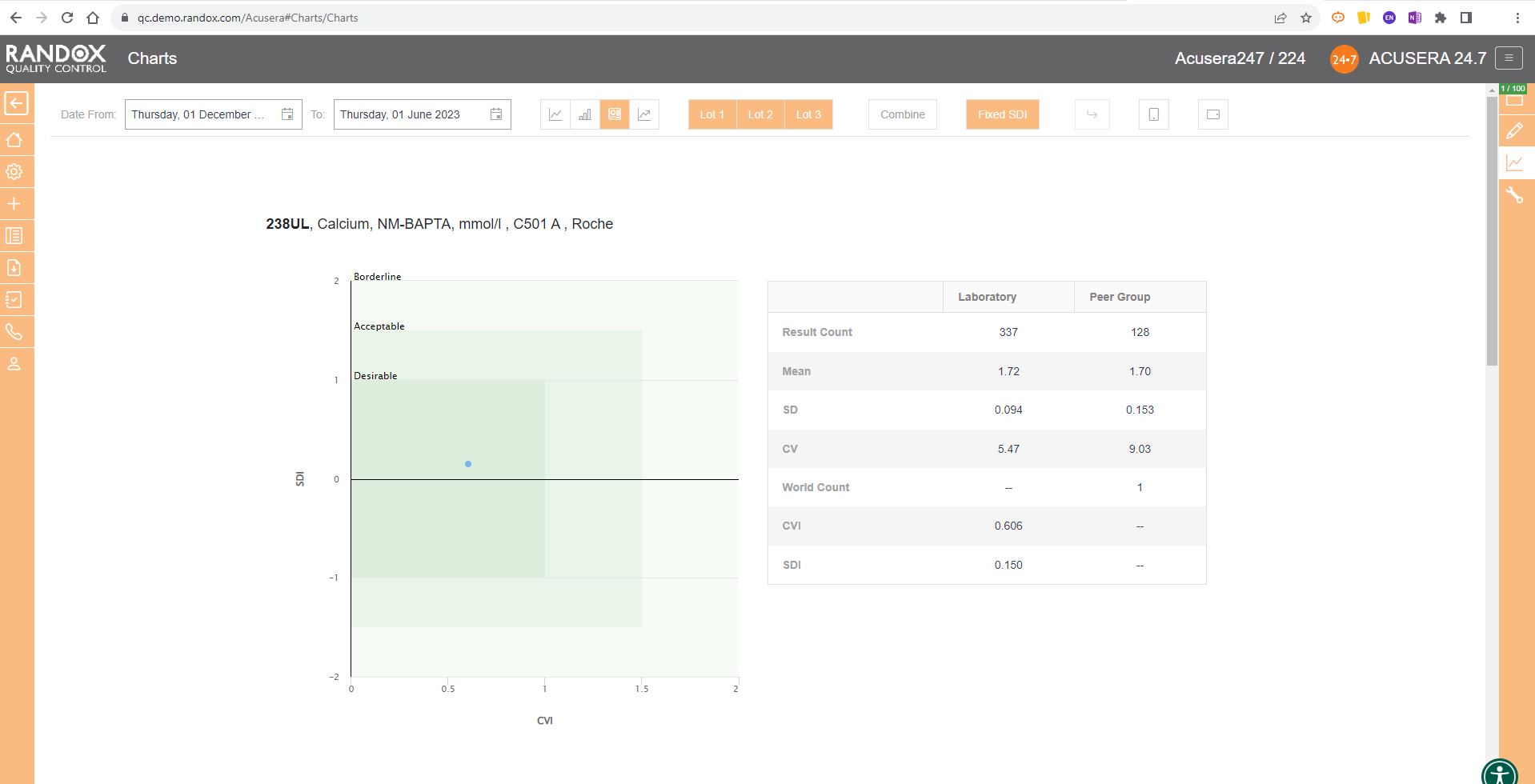
Like the Levey-Jennings charts, you can also combine this information for panels or a selection of multiple lots and analytes. You can see an example below:
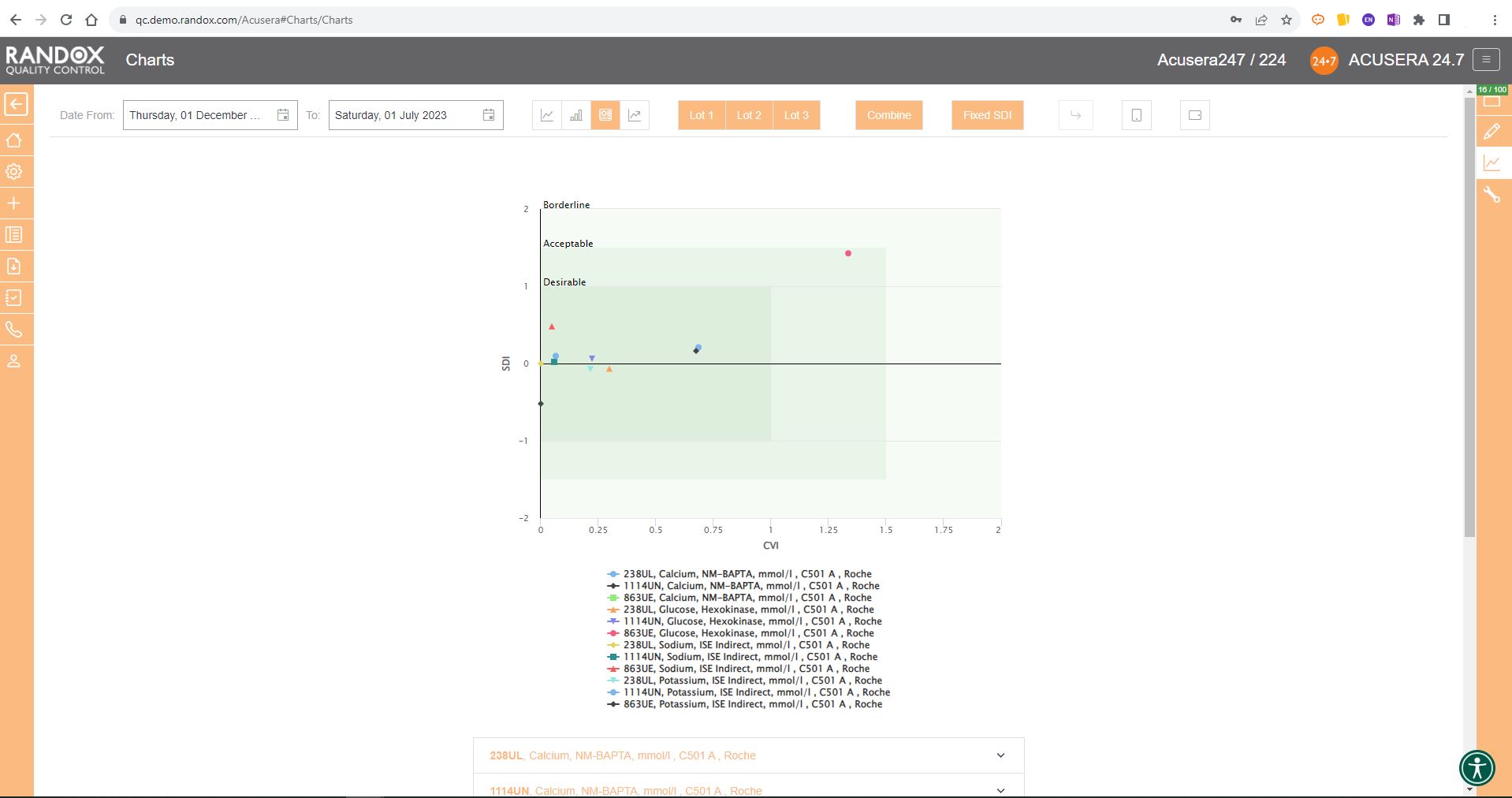
Weekly Mean Charts
Weekly Mean Charts are one of the new features in our latest software release.
They allow you to view your weekly count of QC results for a specific instrument, assay, or lot.
Below is an example in a bar chart format.
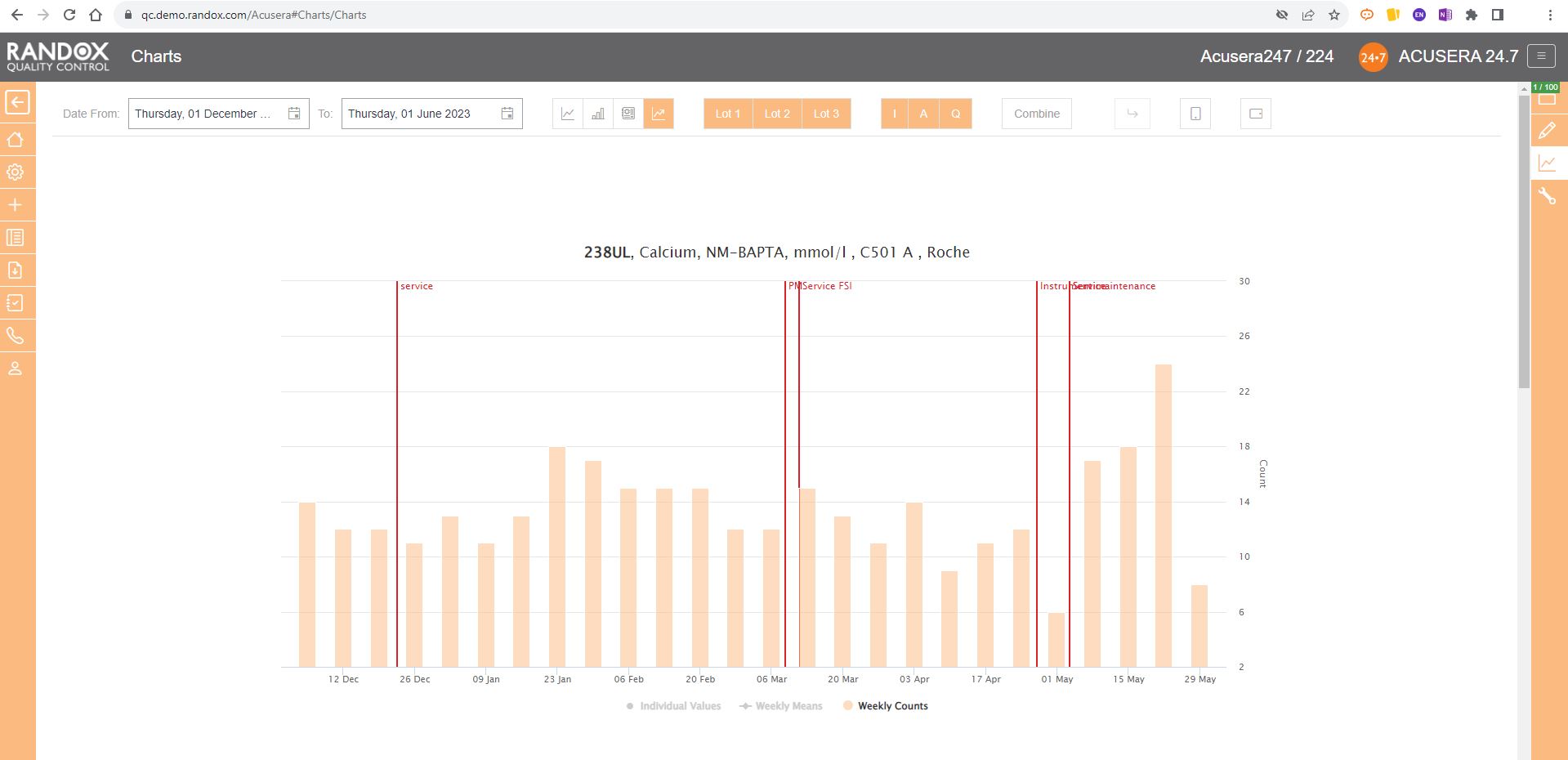
You can also view this data as a line graph, which plots the weekly mean of results from multiple instruments using the same assay and QC lot, allowing a comprehensive overview of your QC data.
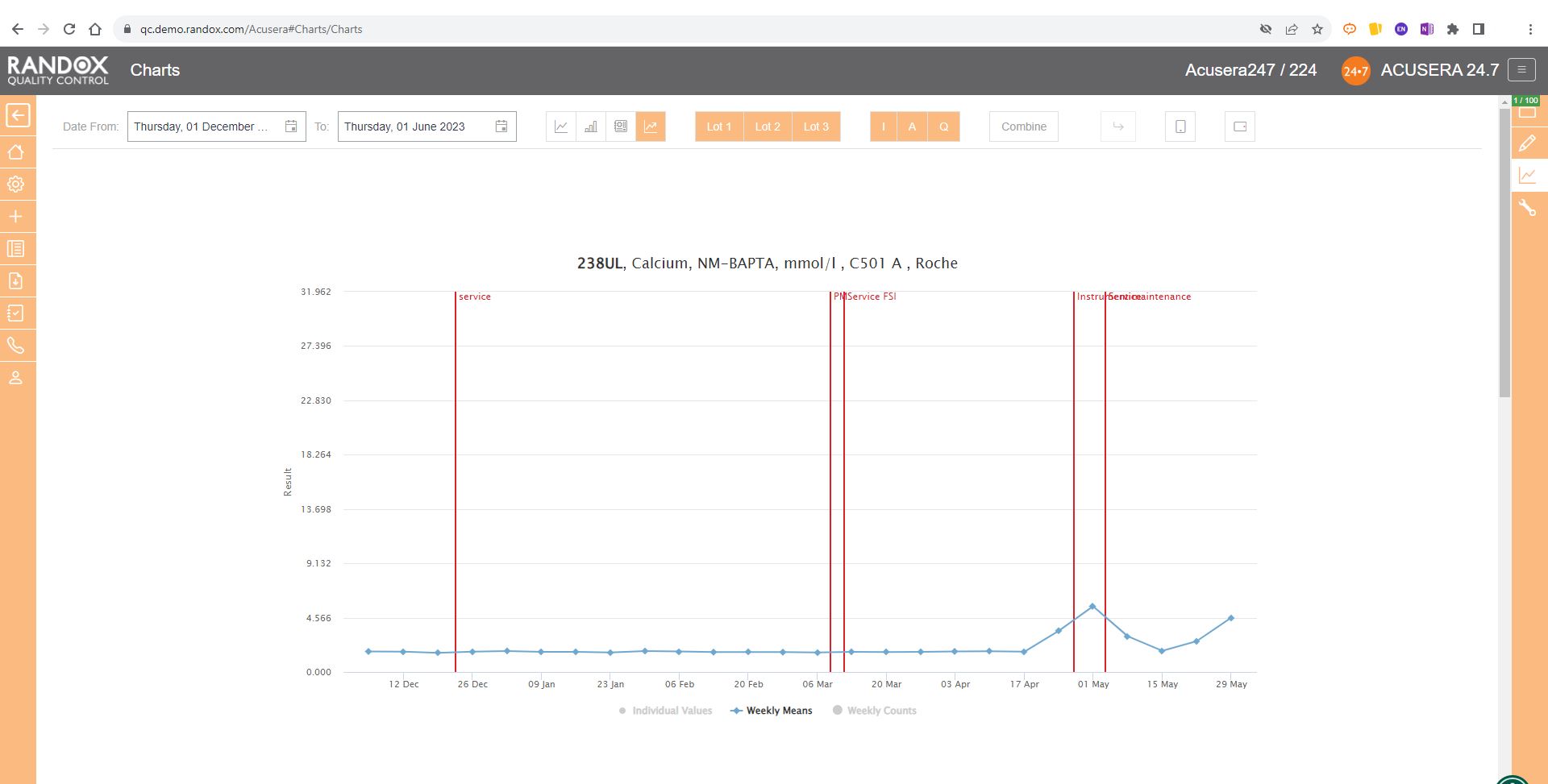
Or you can view your weekly means for a range of tests and panels.
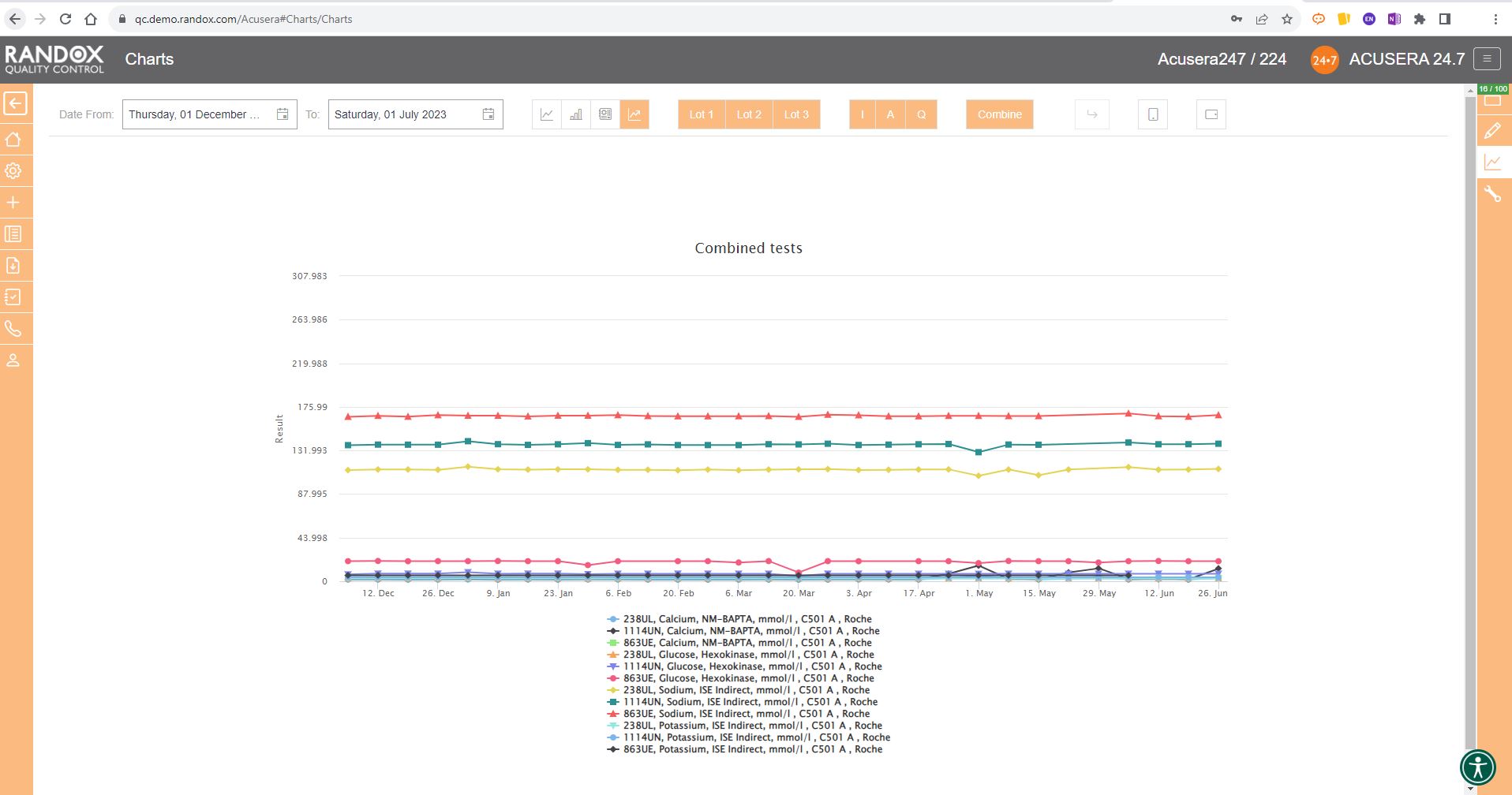
Finally, the SD Histograms allow you to view the distribution of your results, for an overview of performance.
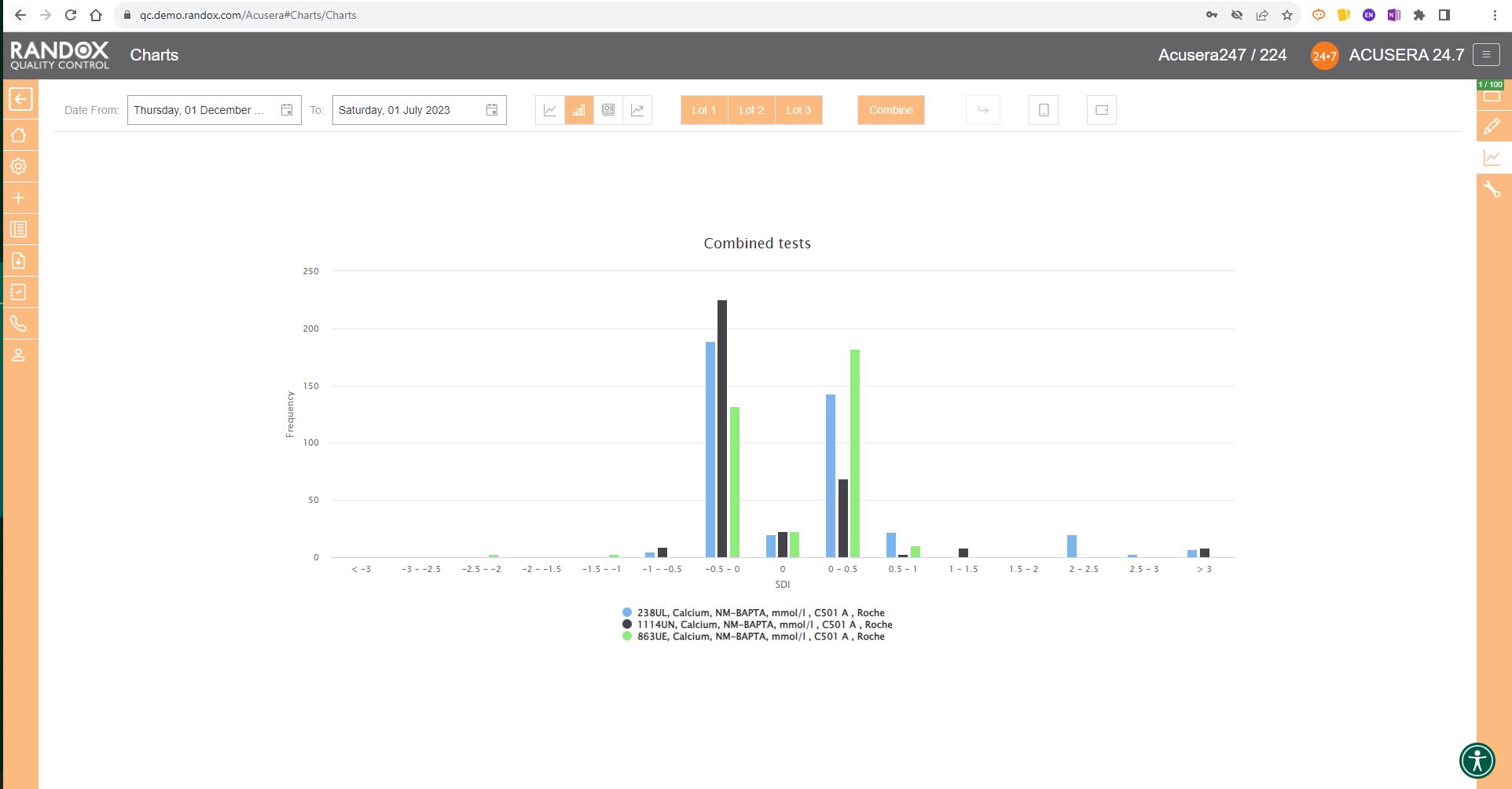
When used with Acusera 24.7’s suite of advanced statistical tools and reports, our charts can help you reduce the time you spend investigating non-conformances.
When the dreaded accreditation assessment approaches, you can relax. While others are scrambling to find documentation, you can rest assured that all the QC data you need is easily accessible.
Assessors love to see Acusera 24.7 load when they enter a laboratory because they understand how much easier QC management is when using our software.
We provide complete onboarding assistance and full training on the software for new customers while delivering prompt and effective customer support for existing users. The Acusera 24.7 and QC operations teams are always eager to help new and existing Acusera 24.7 users with any issues they experience.
To learn more about the features of this ground-breaking software, visit our website here.
Alternatively, feel free to reach out to us at marketing@randox.com for more information or to arrange a demo!
Ferritin-Blog

Ferritin Assay
Ferritin, a protein but also an indicator of the body’s iron levels and stores is valuable when tested alongside other proteins and lipids to identify the function of muscle metabolism, transporting oxygen and DNA synthesis.
Anaemia is the cause of iron deficiency, a shortage of red blood cells resulting in the stores being inadequate in meeting the necessary needs for metabolism. Literature has identified that this could be the result of haemolysis and excessive bleeding. Testing regarding Ferritin, renal function and glucose are used to determine the sole cause of anaemia. Some symptoms of this deficiency include extreme fatigue, decreased productivity, diminished physical performance and significantly reduced immunity. However, in stark contrast having an over accumulation of iron in the body can be the result of hereditary disorders of haemochromatosis and thalassaemia.
Iron seeks to bind with a protein as it’s very reactive as a biomarker, so while being stored in cells iron binds to Ferritin, this in turn makes Ferritin an ideal predictor of iron reserves. Toxicity from elemental iron causes tissue damage and collates free radicals. Excess iron collated in the body over time causes serious damage to the liver and vital organs, causing liver failure, cirrhosis, skin pigmentation, heart failure and arrythmia. There is no way to eliminate excess iron from the body, so regulation of iron stores is vital to check of changes in iron absorption. As Ferritin is the primary iron storage, without it iron levels cannot be regulated and can cause serious damage.
Ferritin itself is produced on a very small level before being released in the bloodstream. During inflammation episodes, due to infections, rare conditions or even obesity, Ferritin levels can become significantly elevated. It poses as a challenge to accurately diagnose iron deficiency and can unfortunately lead to a misled evaluation regarding the possible overload of iron. This issue is being worked on to resolve and be able to accurately measure iron levels while inflammation is present. CRP may also be used as an aid to help rule out the elevated Ferritin levels from the cause of inflammation.
Ferritin is described as ‘an intracellular hollow protein’, comprised of around 4500 iron atoms within the iron core, surrounding the core are 24 subunits. In contrast, a reduced Ferritin level in serum indicates a deficiency and or depletion of iron stores, however it may not determine advanced depletion.
Randox Laboratories offer an accurate Ferritin Assay, used to detect iron levels and aid in the diagnosis and treatment of conditions such as anaemia.

‘Benefits of the Ferritin Assay include’.
Wide measuring range of 5.08 – 443 mg/dl for the accurate detection of clinically important results
Automated immunoturbidimetric assay eliminating the need for any dedicated equipment.
Liquid ready-to-use reagents for convenience and ease-of-use
Stable to expiry when stored at +2 to +8°C.
Applications available detailing instrument-specific settings for the convenient use of the Randox Ferritin assay on a wide range of biochemistry analysers
Complementary controls and calibrators offering a complete testing package.
Some clinical points to note include. Ferritin has been observed in 89% of patients with Adult-Onset Stills Disease, there have been elevated Ferritin levels of five times the normal range in over half of patients with this disease. COVID-19 critically ill patients experienced elevated concentrations, along with Sepsis patients that are not recovering also experience a stark increase in their Ferritin levels.
Click the link below to find out more on our Ferritin Assay!
References
Fernandez-Alvarez R, Gonzalez-Rodriguez AP, Gonzalez E, Rubio-Castro A, Dominguez-Iglesias F, et al. Serum Ferritin as Prognostic Marker in Classical Hodgkin Lymphoma Treated With ABVD-based Therapy. Leukemia & Lymphoma . 2015;56(11):3096-3102.
Randox (2023) Ferritin: Reagents, Randox Laboratories. Available at: https://www.randox.com/ferritin/ (Accessed: 20 September 2023).
Rosário C, Zandman-Goddard G, Meyron-Holtz EG, D’Cruz DP, Shoenfeld Y. The hyperferritinemic syndrome: macrophage activation syndrome, Still’s disease, septic shock and catastrophic antiphospholipid syndrome. BMC Medicine . 2013;11(185).
Sharma J, Sharma R. A prognostic marker in patients with sepsis in pediatric age group: A prospective cohort study. International Journal of Medical and Health Research . 2018;4(3):86-89.
The Royal College of Pathologists. Guidance on the Use and Interpretation of Clinical Biochemistry Tests in Patients with COVID-19 Infection.; 2020. Accessed September 18, 2023. https://www.rcpath.org/uploads/assets/3f1048e5-22ea-4bda-953af20671771524/G217-RCPath-guidance-on-use-and-interpretation-of-clinical-biochemistry-tests-in-patients-with-COVID-19-infection.pdf
World Health Organisation. WHO Guideline on Use of Ferritin Concentrations to Assess Iron Status in Individuals and Populations.; 2020. Accessed September 18, 2023. https://www.who.int/publications/i/item/9789240000124
From Fear to Freedom: A QC Data Management Revolution
What if we told you we had a solution to the multitude of monotonous hours spent analysing reams of IQC data and could provide you with an intuitive tool packed with comprehensive and customisable reports, interactive charts, and automated statistical analysis to help improve your QC data management?
Perhaps it sounds too good to be true?
This time, it isn’t.
Uncertainty of Measurement. 6Sigma. QC Multi-rules. These words can strike fear into the hearts of even the most experienced laboratory staff.
With Acusera 24.7, we’ve reached under the bed and forced the monster that is advanced statistical analysis out into the cold.
Acusera 24.7 is a live, cloud-based, interlaboratory QC data management and peer group comparison software.
A mouthful. I know.
But let’s break it down
A live, cloud-based software means you can access your QC data from anywhere, anytime.
Bid farewell to the labyrinth of folders you hunt through when troubleshooting or looking for a specific dataset.
Interlaboratory management describes the momentous task many QC managers face – monitoring the QC performance of multiple laboratories in different locations, ensuring they all maintain the high standards required for accreditation and accurate patient results.
Unlike some big-name subscription services, we encourage you to use our software at different locations to help you monitor all your laboratories and instruments to see how their results stack up against one another.
Acusera 24.7 provides multiple levels of access which are completely customisable. This allows you to grant or restrict access to different parts of the software depending on what is required by your staff. This also allows QC managers to view data from all their sites in one location without needing multiple email chains from each laboratory.
Peer group comparison? Isn’t that what EQA is for?
Well, you would be right.
Yes, EQA does provide a comparison with your peer group, but it doesn’t have exclusive rights.
There are many benefits to comparing your IQC data with your peer group. The real-time comparison data aids with troubleshooting, or you can show off how great you are to your friends and colleagues.
You can select your peer group for an instrument, method and more, providing you with a comprehensive picture of how your laboratory performance compares to your peers using the same lot of control.
There are no submission deadlines. One less thing for you to worry about.
Still think it sounds too good to be true?
Then let’s look at some of the software features and how they can be used to make your daily QC data management easier.
Charts
For many laboratories, review of their QC data is a momentous task involving an abundance of printouts with different data tables and graphs and hastily scribbled notes going back maybe months, if not years.
With Acusera 24.7’s interactive Levey-Jennings charts, you can see the QC data from a specified date range. This helps visualise trends and biases over any period to simplify the troubleshooting and lot validation processes, or, can be used as evidence during accreditation assessments. These charts can be generated for a single analyte or for multiple analytes and QC levels.
You can also add events to the graph to record factors that might impact the performance of your analyser such as preventive maintenance, calibrations or switching QC lots. So, when you come to review the QC data and see a shift in the results, you can see at a glance if there was an explanation for the change in QC results.
What’s more, the points plotted on the chart will appear in orange or red if they trigger your alert or reject protocols respectively. Those that appear as a triangle indicate a comment is attached. Comments can be added to any data point directly on the Levey-Jennings chart, allowing you to record any information relevant to the data, saving you time, not to mention the cost of all those sticky notes.

This complements the Panel feature of the software. Within Acusera 24.7 you can create a panel of tests, for example, a Liver Function Test panel, grouping all the tests together. You can then view all the QC data for this panel at the click of a few buttons. Shown below is the collective data for a clinical chemistry panel.
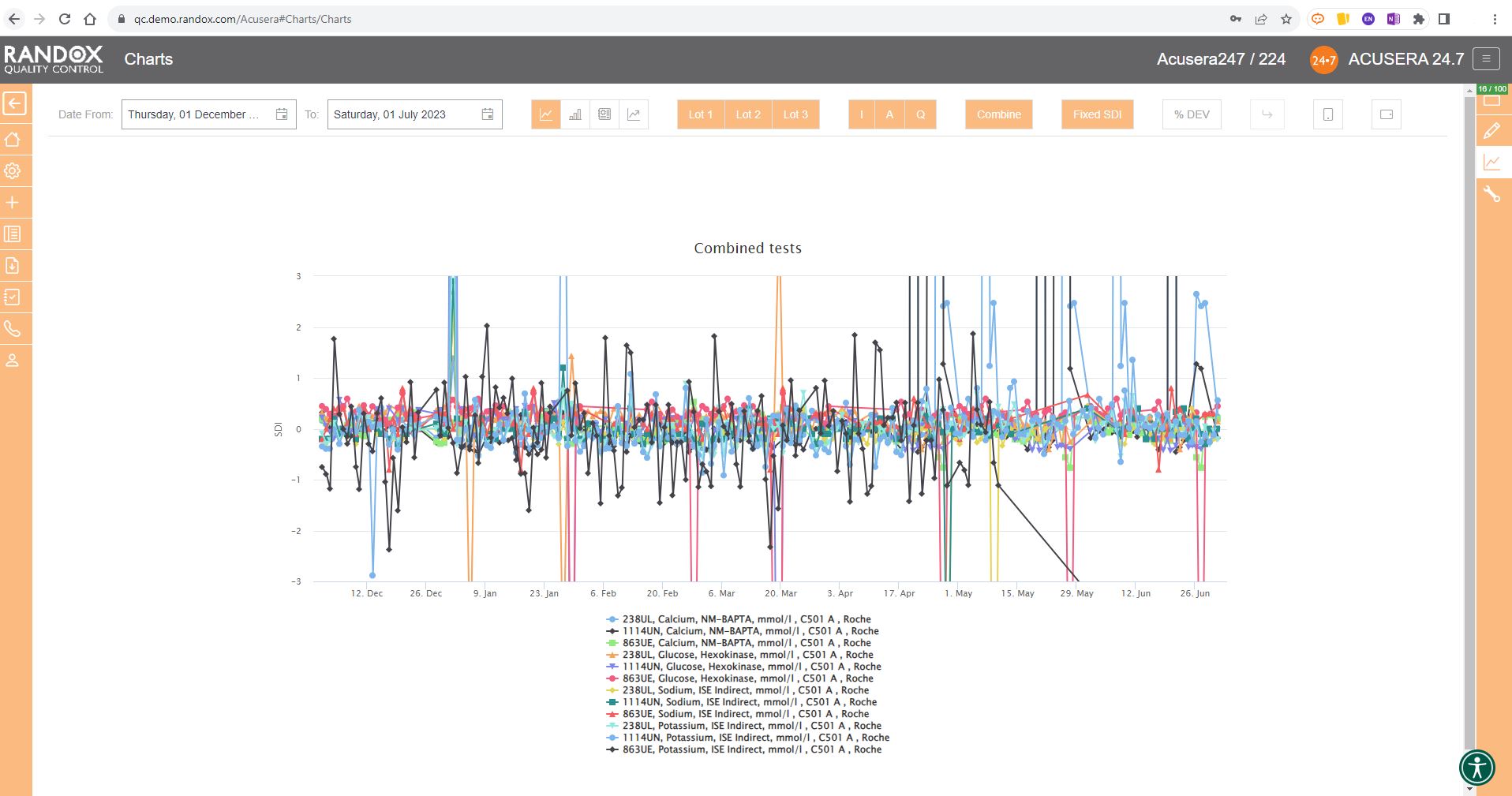
When you do need the paper copy, all the charts and reports found in Acusera 24.7 can be exported to Excel or PDF for independent analysis or printing, making it easy to bring your data to meetings or for hardcopy filing and audits.
For peer group comparison, you can get a performance summary chart. This chart basically does the analysis for you! You define the date and time range, and the software looks at all the data points within it for you and your peer group, comparing individual data, means, CVs and SDs. Like our other charts, you can combine any number of these for multi-analyte analysis.
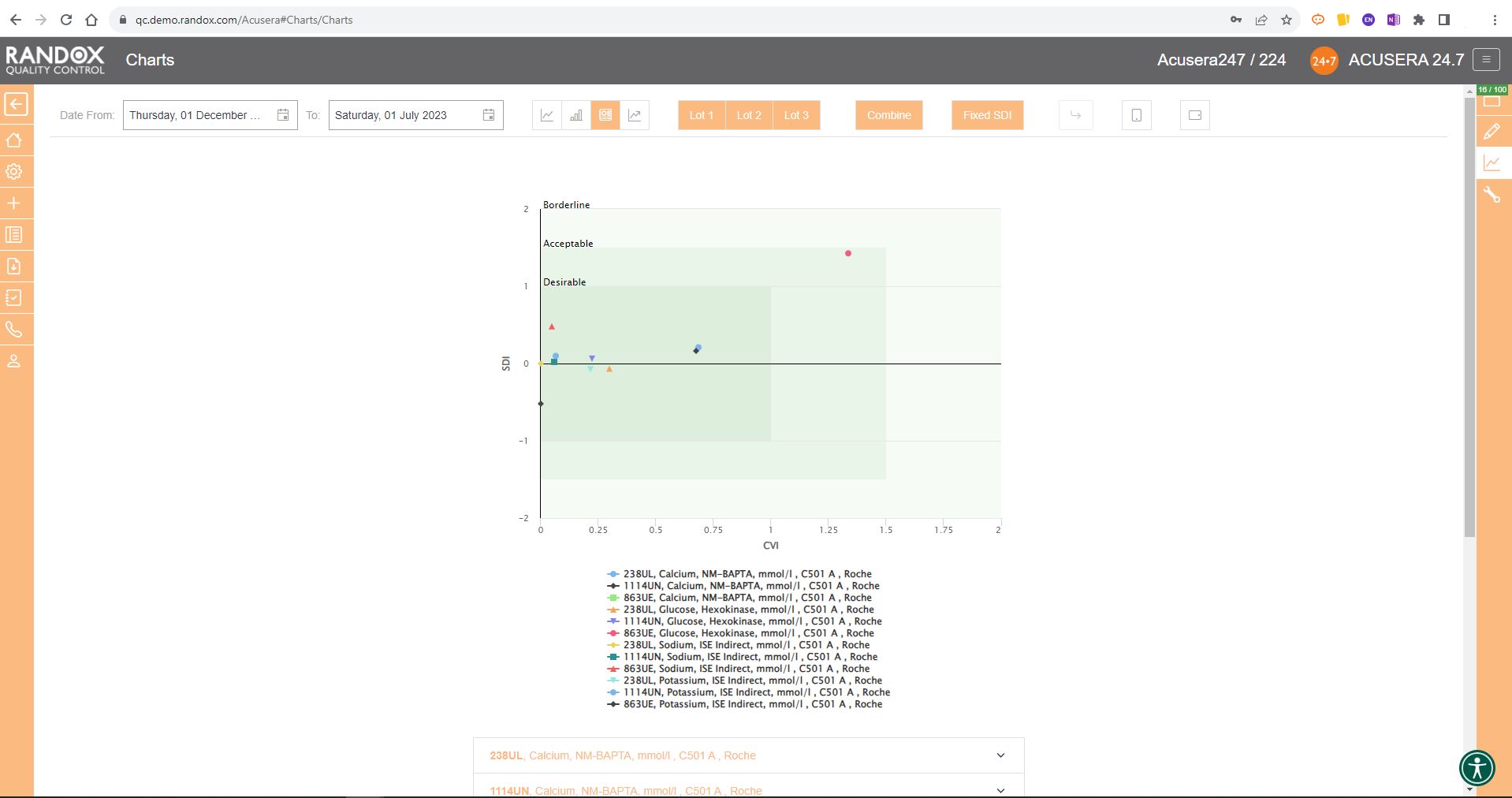
Advanced Statistics
Some people love statistics. Others can think of nothing worse.
Either way, there’s a lot of work involved in advanced statistical analysis.
Even if you’re in the love camp, you might find yourself sickened before you’ve finished this metaphorical jar of marmite.
The role of a pathology laboratory is not to run QC and show off their statistical skills, but to provide accurate and appropriate patient results.
As the old saying goes, time is money.
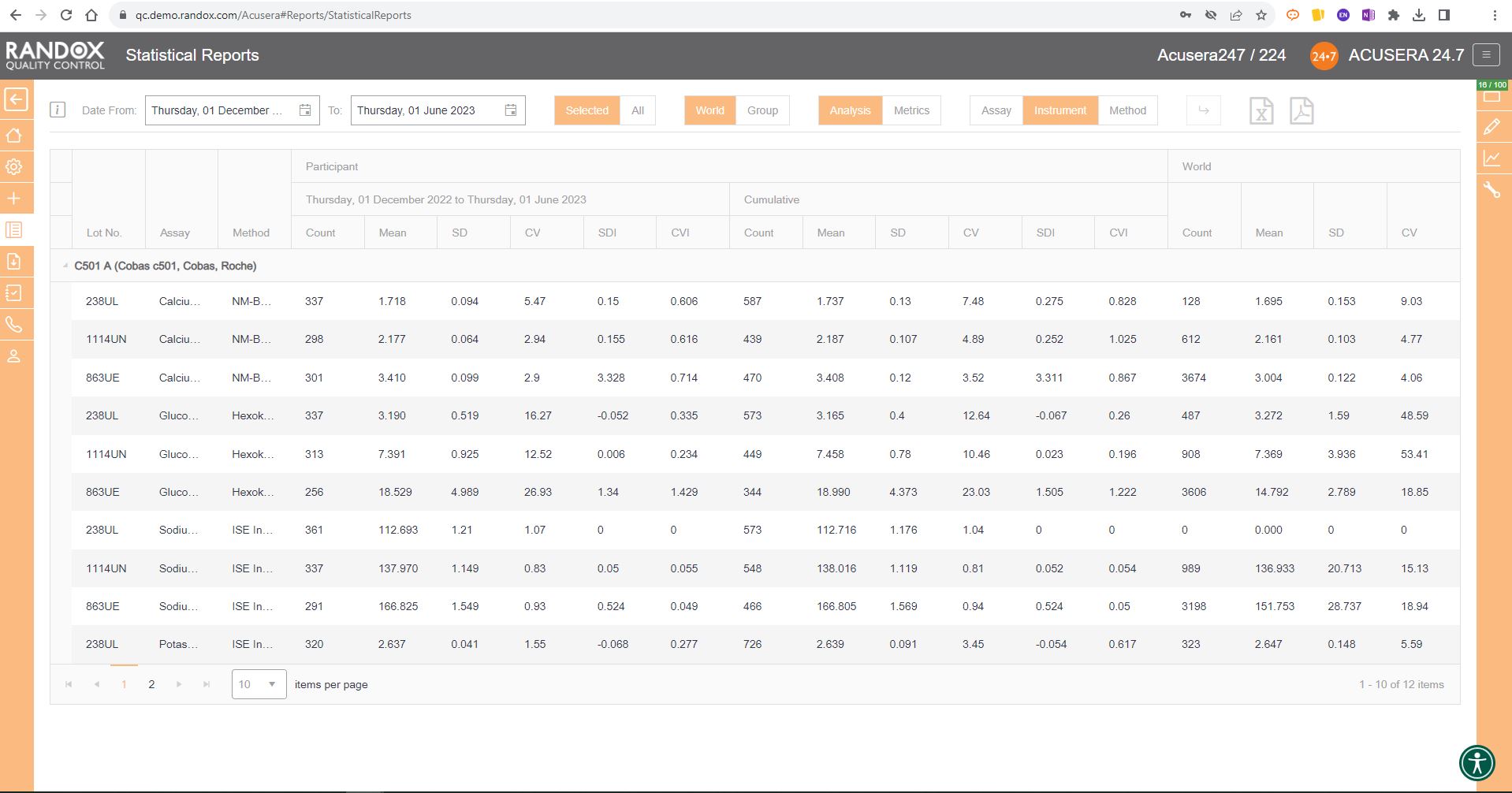
But in your case, time is the difference between a fast or delayed diagnosis for a patient.
This may impact their condition or treatment.
By making use of the suite of statistical options included in Acusera 24.7, including QC Multi-rules, 6Sigma and Uncertainty of Measurement, you can focus on providing the most accurate and efficient testing for patients.
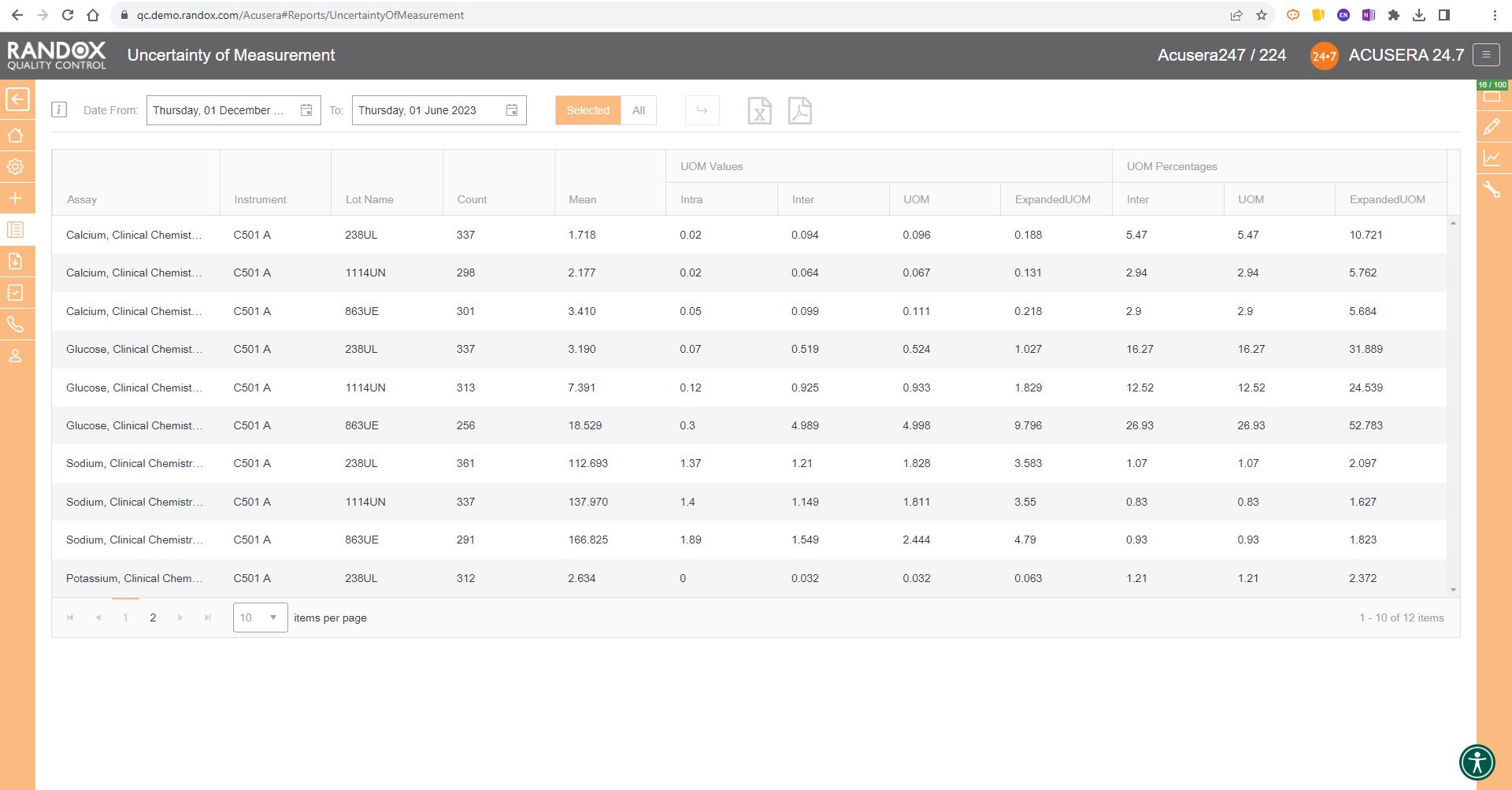
Data Entry
To save even more time, Acusera 24.7 can be integrated with many LIMS or Middleware packages for fully automated data transfer. At a predefined time, your internal software will send your QC data to a shared folder on your network and from there to a Randox Cloud IP address, meaning we don’t go into your IT system and take anything; we won’t cause any information security problems. This data is then taken from the cloud and populated onto 24.7.
All this in less time than it takes you to say, ‘fully automated data transfer.’
You can also import your data through a semi-automated upload procedure. For this, the data is exported from your LIMS or middleware and imported manually to your Acusera 24.7 account using an EDI import file. Simply put, all you have to do is send the file, and the software will populate it onto the system. Alternatively, you can upload the data manually on the simple and intuitive data entry page.
Acusera 24.7, while comprehensive and initially daunting due to its vast array of features, is incredibly easy to use. The Acusera 24.7 and QC operations teams are always eager to help new and existing Acusera 24.7 users with any issues they experience. We provide complete onboarding assistance and full training on the software for new customers while delivering prompt and effective customer support for existing users.
We’ve only begun to cover the range of features available on Acusera 24.7 for QC data management! For more information or to arrange a demo, get in touch with our team at marketing@randox.com. Or, you can take a look at our website here.
Sexual Health Week

September 11th-17th is Sexual Health Week
Sexual Health is a very important part of our lives, impacting on our wider physical and emotional well-being. In our relationships it is also important to act responsibly and with care – and to reduce the risk of Sexually Transmitted Infections (STIs).
More than one million sexually transmitted infections (STIs) are acquired every day worldwide, the majority of which are asymptomatic. STIs are on the increase, and many show very little to no symptoms.
We want to break the stigma on sexual health testing. Regular testing is what keeps us safe and prevents STI’s spreading. Regular screening can aid in detecting an infection in the early stages and help to reduce the risk of further complications.
Gonorrhoea and Syphilis, which are two of the most common STIs are increasing at alarming rates.
Usually treated easily with antibiotics, many STIs can cause serious health issues if left untreated. Chlamydia and Gonorrhoea can cause infertility and pelvic inflammatory disease, while syphilis can cause serious, irreversible, and potentially life-threatening problems with your brain, heart, or nerves. Sexually transmitted infections are on the increase, many of which present little to no active symptoms.
Blood Pressure Awareness Week

4th – 10th September is this years Blood Pressure Awareness week, also known as ‘Know your numbers week.’
It is estimated that 16 million people in the UK have high blood pressure, but around a third are unware that they have it – if left untreated, it can often cause heart attacks or stroke and is also a risk factor for heart disease, kidney disease and vascular dementia.
People with High Blood often show no symptoms but awareness of it can make it easily treatable and manageable.
Your blood pressure is an essential part of the successful circulation of blood around your body. When your heart contracts, it propels blood outward with force, circulating it around all the arteries in your body.
When healthy and relaxed, your arteries are flexible and provide just the right amount of resistance to enable efficient blood flow.
But what does that mean exactly?
High blood pressure is the result of the stiffening and constriction of your arteries. These narrower, more rigid arteries cause higher resistance to blood flow, ultimately causing the heart to work harder to pump the blood to the farthest parts of you.
Over time, this additional work can cause damage to the myocardium, or heart muscle, as well as other organs like the brain and kidneys. Know Your Numbers Week, organized by Blood Pressure UK, is an annual event in September that aims to increase awareness of the dangers of high blood pressure, promote the importance of knowing your blood pressure and provide you with information on how you can help lower yours.
Home testing kits have made it easy and convenient for people to test for health concerns from the comfort of their own homes – this allows them to begin taking steps to target at-risk areas. Home monitoring is both an effective and inexpensive way to keep blood pressure under control.
With Randox Health’s easy-to-use Heart Health home testing kit you can find out your cholesterol levels from the comfort of your home. This health test is available from £29 and measures total cholesterol, HDL (good) cholesterol. LDL (bad) cholesterol and triglycerides.
Our easy-to-interpret Heart Health report will provide a breakdown of your results.
Available at www.randoxhealth.com

Differentiating Viral from Bacterial Infections
Estimates claim that over 1.2 million people died in 2019 as a direct result of an antibiotic-resistant bacterial infection. Statistics show that up to 4.95 million deaths in the same year were associated with antimicrobial resistance (AMR)1. The overuse and misuse of antibiotics is considered to be the largest contributing factor to the rise of AMR. Antibiotics are effective at treating a wide range of bacterial infections, however, when used to treat viral infections, they have little to no effect. Even still, many physicians continue to prescribe so-called empirical antibiotics as an all-encompassing treatment strategy. In their defence, differentiating viral from bacterial infections can be troublesome. Traditional testing takes the form of paired serology, which requires patients to visit a healthcare facility twice during a 2–4-week period. Many of these infections have distressing symptoms, making this an unreasonable time-to-diagnosis period. Novel molecular techniques can reduce the time to result in the determination of many infections. However, some of these methods are associated with high false positive rates and low specificity resulting in further misuse of antibiotics.
Mxyovirus resistance protein A (MxA) is a biomarker associated with viral infections. It displays antiviral activity against positive, double-stranded RNA viruses and some DNA viruses2. In a study from earlier this year, MxA was used to differentiate viral from bacterial infections in a cohort of 61 adults with an AUROC of 0.9 and a sensitivity and specificity of 92.3% and 84.6% respectively3. An additional study, known as the TREND study, found that a cut-off of 430μg/L could effectively differentiate bacterial and viral infections with an AUROC of 0.9, a sensitivity of 92% and a specificity of 100%4.
C-reactive protein (CRP) is a non-specific acute phase protein which is associated with bacterial infection. However, CRP levels have also been shown to be elevated in response to various viral infections such as Influenza virus, malaria5 and SARS-COV-26, limiting its utility in differentiating the aetiology of an infection.
Using both biomarkers in combination can help physicians determine the true aetiology of infection with high specificity, supporting antimicrobial stewardship and reducing the harmful use of these drugs. Available on the VeraSTAT, Randox provides tests for MxA and CRP, which together provide a fast and accurate method of detection and differentiation of bacterial and viral infections from a small sample.
Alternatively, don’t hesitate to browse our range on our website or get in touch with one of our team at marketing@randox.com who will be happy to help with any query you have!
References
- Murray CJL, Ikuta KS, Sharara F, et al. Global burden of bacterial antimicrobial resistance in 2019: a systematic analysis. The Lancet. 2022;399(10325):629-655. doi:10.1016/S0140-6736(21)02724-0
- Liao S, Gao S. MxA: a broadly acting effector of interferon-induced human innate immunity. Visualized Cancer Medicine. 2022;3:2. doi:10.1051/vcm/2022002
- Metz M, Gualdoni GA, Winkler HM, et al. MxA for differentiating viral and bacterial infections in adults: a prospective, exploratory study. Infection. Published online February 3, 2023. doi:10.1007/s15010-023-01986-0
- Rhedin S, Eklundh A, Ryd-Rinder M, et al. Myxovirus resistance protein A for discriminating between viral and bacterial lower respiratory tract infections in children – The TREND study. Clinical Microbiology and Infection. 2022;28(9):1251-1257. doi:10.1016/j.cmi.2022.05.008
- Joseph P, Godofsky E. Outpatient Antibiotic Stewardship: A Growing Frontier—Combining Myxovirus Resistance Protein A With Other Biomarkers to Improve Antibiotic Use. Open Forum Infect Dis. 2018;5(2). doi:10.1093/ofid/ofy024
- Paranga TG, Pavel-Tanasa M, Constantinescu D, et al. Comparison of C-reactive protein with distinct hyperinflammatory biomarkers in association with COVID-19 severity, mortality and SARS-CoV-2 variants. Front Immunol. 2023;14. doi:10.3389/fimmu.2023.1213246
MSc Health Data programme receives Randox scholarship
The University of Exeter’s MSc Health Data Science programme has received £25,200 from Global Diagnostics company Randox Laboratories to support two places on the programme.
The Randox Health Data Science Scholarship will enable successful applicants to gain access to world-class teaching, in an emerging field of Health Data Science at Exeter, as well as the opportunity to interact with specialists at Randox Laboratories during their masters.
The MSc Health Data Science course at Exeter is designed to equip students with innovative skills needed to tackle some of the biggest health challenges across the world. The programme also teaches the application of quantitative skills such as computing, mathematics, and statistics in the understanding of disease prevention and cure.
Exeter is one of only six UK universities to deliver the MSc Health Data Science programme.
The Scholarship is open to home students only and offers:
- Course fees (on a part-time or a full-time basis), or an equivalent contribution to living expenses.
- The opportunity to visit Randox in Belfast for two placements during the program, including a presentation to the company.
- The opportunity to partner with Randox on your dissertation project which forms an integral part of course credits.
- A Randox internship offer upon completion of studies to gain vital experience and insights into the field of diagnostics health care.
Professor Tim Frayling, programme lead for MSc Health Data Science, said: “The emerging field of data science is changing how we think about everything, including healthcare. There is huge competition for the most gifted students, and we need to encourage talented individuals to develop their skills and meet this demand.
“We are grateful to Randox for this generous donation of the scholarships to support two students who will have the opportunity to advance their knowledge in a vibrant field of health research.”
Dr. Helena Murray, Randox R&D Manager and programme lead for Health Data Science said: “We are in no doubt of the critical importance of Health Data Science as healthcare organisations seek earlier and reliable diagnosis from multiple health data points – many more than can be processed reliably at an individual level. This science offers the opportunity to both greatly improve healthcare outcomes and reduce the burden on healthcare services. There are clearly significant career opportunities in this field.
“We congratulate Exeter University on their Health Data Science programme and look forward to engaging with the successful candidates.”

Randox scholarships are additionally available to prospective eligible MSc Health Data Science students, according to the OfS criteria. The deadline for applications is August 14th 2023.
Pursuing Perfection: Insights into Global IQC Practices
In a time when medical laboratory personnel are pushed to their limits, internal quality control and quality management are easy to consider a nuisance. However, these processes are vital to ensure accuracy and precision in the potentially life-saving tests performed in these laboratories. Most High-to-middle-income countries have strict regulations governing quality procedures in medical laboratories, but global standardisation in these areas is lacking. Over 70% of clinical decisions are based on laboratory testing but many clinicians are unaware of the accuracy and precision limitations associated with many of these tests. This places the responsibility on laboratory staff to ensure that all results provided to clinical decision-makers are as true as possible. For this, they rely on IQC and a robust quality management system.
To determine the state of the industry, a report by the International Federation of Clinical Chemistry and Laboratory Medicine (IFCC) Task Force on Global Laboratory Quality (TF-GLQ) surveyed over 100 IFCC full and affiliate members, receiving responses from 46 countries1. This survey consisted of a series of multiple-choice questions in relation to quality practices in their respective countries.
Findings by IFCC Task Force on Global Laboratory Quality
90% of respondents indicated that quality standards are in use in their country, despite being mandatory in only 46.7% of those countries.
These responses are encouraging showing that at least some level of predefined QC practice is implemented even in countries that do not legislatively mandate the inclusion of quality standards. This also hints that in those countries where it is not mandatory, it may soon become a requirement to adhere to a specified QC system. Nevertheless, in countries where regulatory measures are currently absent, the rigour of the implemented quality control procedures may not be adequate to ensure the accurate reporting of results.
42.5% of respondents indicated that IQC was not run in all laboratories in their country.
These respondents indicated that IQC is run in 50-99% of laboratories in their country. This less encouraging result shows that minimum IQC practices are not implemented globally. However, due to the multiple-choice nature of this survey, it is difficult to determine how drastic this issue is. Although it does raise the question of how these laboratories verify the precision of their results.
66.7% of respondents indicated that they use assay manufacturer quality control material.
This refers to first party quality control materials which are optimised by the manufacturer for use with a specific assay, instrument or method. These controls are often manufactured from the same material as the calibrator, making them less sensitive to subtle changes in performance, allowing them to mask weaknesses in the assay in question and therefore should be considered less effective options than third-party controls. Additionally, ISO15189:2022 encourage the use of third-party controls and require laboratories seeking accreditation that do not use third party controls to provide a sufficient explanation as to why this is the case.
60% of respondents indicated that not all laboratories in their country had written IQC policies and procedures.
This highlights an important aspect of a quality management system. Without written IQC policies and procedures it is almost impossible to standardise the IQC process and corrective action across laboratory staff, never mind on a national scale. Drafting this documentation can be cumbersome, however, many organisations can be contracted to assist with the drafting and implementation of these procedures for laboratories seeking to gain accreditation.
28.6% of respondents reported that manual interpretation of the IQC data was normal practice.
Manual data interpretation also poses challenges to the standardisation of IQC processes. Written IQC policies and procedures are crucial in implementing standard acceptance criteria for IQC results. Manual data interpretation also implements restrictions on the ability to carry out more advanced statistical analysis of the QC data.
Discussion
The implementation of robust IQC practices is crucial for ensuring the trueness and precision of the results produced by a laboratory. Used correctly, IQC can monitor variability caused by instrumentation and lot changes as well as various other sources of analytical error. ISO15189:2022 provides a thorough framework for designing rigorous IQC policies and procedures, highlighting key areas such as the use of third party QC material, levels of QC material, the frequency at which IQC should be completed, matrix composition, acceptance/rejection criteria and non-conformance procedures. For more information on ISO15189:2022 accreditation, take a look at our educational guide ISO15189:2022 Updates.
The results from this survey conducted by IFCC show a clear disparity between IQC processes around the globe, displaying differences in requirements, recommendations, and legislation. Standardisation of IQC is not without its challenges. However, by striving to achieve the highest possible levels of quality, and following the guidance laid out in ISO15189:2022, laboratories can be confident in the results they provide to clinicians.
Acusera Quality Control
The Acusera range offers unbiased, independent third party quality controls for medical and research laboratories of all shapes and sizes. Our assayed controls are provided with target values for most commercially available analysers, ensuring that your test menu will be covered. With enhanced stability, commutability and consolidation, all our controls are manufactured to provide a clinically relevant challenge to your test method, aiding in ISO15189 accreditation. For more specialist laboratories, our teams are happy to discuss your requirements and help to provide bespoke quality control material, providing an extremely flexible QC range.
Acusera 24.7
Designed for use with the Acusera range of third party controls, the Acusera 24•7 software will help you monitor and interpret your QC data. Access to an impressive range of features, including interactive charts, the automatic calculation of Measurement Uncertainty & Sigma Metrics and live peer group data generated from our extensive database of laboratory participants, ensures Acusera 24•7 is the most comprehensive package available. For laboratories performing manual review of their IQC data, Acusera 24•7 provides a comprehensive yet easy-to-use platform for advanced statistical analysis and monitoring of these data.
For more information on our Acusera range of IQC material, or Acusera 24•7, feel free to reach out to us at marketing@randox.com or alternatively, browse our range of literature at the QC Resource Hub
References
- Wheeler SE, Blasutig IM, Dabla PK, et al. Quality standards and internal quality control practices in medical laboratories: an IFCC global survey of member societies. Clinical Chemistry and Laboratory Medicine (CCLM). 2023;0(0). doi:10.1515/cclm-2023-0492
RX Imola: Inflammatory Biomarkers in COVID-19
Over the course of human history, few events have had such a dramatic impact as the COVID-19 pandemic. According to the World Health Organization (WHO), as of 12th July 2023, the SARS-CoV-2 virus has claimed almost 7 million lives and figures continue to rise1. While many who become infected are only subject to mild symptoms, those who develop a more severe form of the infection are encumbered with a debilitating flu-like condition, often requiring days, if not weeks of bed rest. In a paper from June 20232, the Rx Imola was used to study C reactive protein concentrations, along with other biomarkers, in mild and severe COVID-19 patients in order to develop novel risk stratification methods for this potentially life-threatening viral infection.
The impact on healthcare services around the world cannot be understated. In developed countries, access to services for both COVID-related and other conditions took a catastrophic hit. In low-to-middle-income countries, the impact has been even more distressing, all but eliminating basic medical care in favour of combating COVID-19, partly due to inferior resources and facilities3.
In times of medical emergency, it is crucial to have an efficient and effective means of stratifying the risk to patients and a process for suitably categorising those into the least and most at risk of severe complications or death. Due to the rate at which COVID-19 spread, unfortunately, the world lacked these mechanisms for SARS-CoV-2, resulting in mass hospital overpopulation, cancelled appointments for other life-threatening conditions and ultimately the staggering mortality statistics we’ve been bombarded with since January 2022. This prompted an unprecedented surge in medical research and major advances in testing capabilities, giving us new methods of detecting SARS-CoV-2 and determining the risk posed to individuals.
One such investigation, by Paranga et al., (2023) studied a total of 13 biomarkers to determine which could accurately differentiate mild, moderate, and severe cases and identify biomarkers which were good predictors of fatality2. C reactive protein (CRP) was the best-described biomarker relating to COVID-19 throughout the pandemic. This paper compares it to 12 other biomarkers including suPAR, sTREM-1, ferritin, MCP-1 and Lactate dehydrogenase. Of these, it was discovered that CRP was clearly the most effective biomarker for differentiating mild from severe cases, with concentrations in those with severe infection being, on average, 45% higher than in those with mild symptoms2. Additionally, the authors discovered that CRP levels were not significantly affected by age, a factor known to affect the inflammation and immune responses, providing a powerful and inclusive risk stratification tool. Some of the additional conclusions drawn from this paper can be seen below2:
- Lactate dehydrogenase, sTREM-1 and HGF were good predictors of mortality in COVID-19.
- suPAR was identified as a crucial molecule in characterising Delta variant infection and mortality.
- The initial values of inflammatory biomarkers were good to excellent predictors of disease severity in COVID-19 patients.
- Disease severity and mortality are associated with a higher rate of comorbidities including thrombocytopenia and other blood diseases, circulatory and respiratory system diseases and liver diseases such as cirrhosis.
So, what is CRP and how does it become elevated in response to a SARS-CoV-2 infection? CRP is a non-specific, acute-phase protein, meaning its concentration is altered in response to inflammation4. The acute respiratory distress syndrome induced by SARS-CoV-2 is, in part, a result of the hyperinflammation caused by the virus2. CRP is a well-characterised inflammatory biomarker and is therefore well-suited for identification and risk stratification in an emerging disease.
This investigation2 utilised the RX Imola, a rapid, comprehensive clinical chemistry platform, to quantify CRP. With the RX Imola, laboratories can gain access to the world’s largest clinical chemistry test menu covering routine chemistries as well as specific proteins, lipids, and more providing a cost-effective and user-friendly platform. With 60 cooled reagent positions and a sample carousel with 20 cooled positions for controls and calibrators, the RX Imola is an ideal solution for small to medium-throughput laboratories seeking an innovative and reliable clinical chemistry system. Randox also supplies suitable, high-quality reagents, and through Acusera, state-of-the-art controls and calibrators, completing the clinical chemistry portfolio.
References
1. World Health Organisation. WHO Coronavirus (COVID-19) Dashboard. https://covid19.who.int/.
2. Paranga TG, Pavel-Tanasa M, Constantinescu D, et al. Comparison of C-reactive protein with distinct hyperinflammatory biomarkers in association with COVID-19 severity, mortality and SARS-CoV-2 variants. Front Immunol. 2023;14. doi:10.3389/fimmu.2023.1213246
3. Jain P. Impact of COVID-19 Pandemic on Global Healthcare Systems and the role of a new era of global collaborations. Sushruta Journal of Health Policy & Opinion. 2021;14(3):1-5. doi:10.38192/14.3.2
4. Nehring S. C Reactive Protein . https://www.statpearls.com/articlelibrary/viewarticle/18744/.






